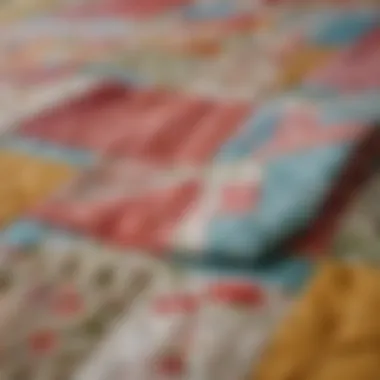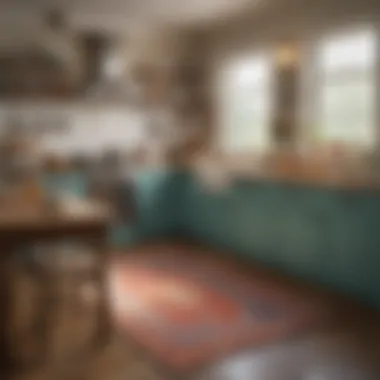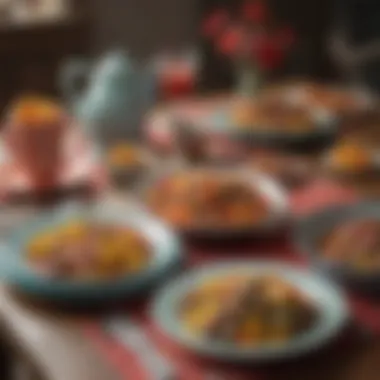Exploring Pioneer Woman Fat Quarters for Crafts and Cooking


Intro
In the realm of crafting and cooking, the intersection of textiles and culinary arts offers a unique canvas for creativity. Pioneer Woman Fat Quarters serve as a definitive example of this synergy, combining vibrant fabric designs with practical applications in both kitchens and crafting spaces. This guide aims to examine the significance of Fat Quarters within the contexts of quilting and culinary endeavors, highlighting their historical roots and modern uses.
Fat Quarters, a term synonymous with quilting, refer to specific cuts of fabric that are often available in themed bundles. The Pioneer Woman brand, which embodies a rustic and cheerful aesthetic, has popularized the use of these fabrics, making them a staple among enthusiasts. Whether one is piecing together a quilt or revamping a kitchen’s ambiance, understanding the utility and character of Fat Quarters can elevate both crafted items and culinary presentations.
Furthermore, this exploration details how to integrate these delightful fabric pieces creatively into home décor, offering practical suggestions alongside meaningful insights into their historical relevance. As we delve deeper, this article will provide not just the how-to, but also the why of utilizing Pioneer Woman Fat Quarters, encouraging a holistic approach to both culinary and crafting practices.
By the end of this guide, readers will possess a thorough understanding of how to engage with Fat Quarters creatively, thereby enhancing both their culinary environments and crafting projects.
Prelude to Pioneer Woman Fat Quarters
Pioneer Woman Fat Quarters hold a special place in both crafting and culinary realms. These distinct fabric pieces encapsulate a connection to heritage, creativity, and practicality. Understanding the essence of these fat quarters can enhance both your crafting projects and your kitchen's aesthetic. This article will explore the definition, the brand’s significant impact, and how these fabric pieces can transform not just quilts, but also cooking experiences.
Defining Fat Quarters
Fat quarters are specific measurements of fabric, typically cut to 18 inches by 22 inches. This size is ideal for quilting, allowing for a variety of designs without excessive waste. The term "fat" refers to the fabric being cut in a way that maximizes usable surface area. Unlike traditional quarter yards, fat quarters are broader but shorter, making them more versatile. They are convenient for small projects, providing crafters with the flexibility to mix and match different patterns and colors. Fat quarters come in diverse prints, enabling limitless combinations for both functional and decorative uses.
The Pioneer Woman Brand Overview
The Pioneer Woman, created by Ree Drummond, embodies a blend of country charm and contemporary flair. Starting as a blog, it has transformed into a brand synonymous with wholesome living, rustic aesthetics, and culinary delights. The brand features various products, including kitchenware, home decor, and, notably, fabric lines. The designs are vibrant, reflective of rural life, and perfect for those looking to bring a touch of homeliness to their environment. The influence of this brand extends beyond just products; it fosters a community of culinary and crafting enthusiasts who share a love for creativity.
In summary, understanding Pioneer Woman Fat Quarters involves recognizing both their practical uses in crafting and the cultural impact of the brand they represent. As we delve deeper, the importance of these fabric pieces in culinary experiences and creative projects will become clearer.
Historical Context of Pioneer Woman
Understanding the historical context of Pioneer Woman Fat Quarters provides a rich backdrop to appreciate their cultural and practical significance. The influence of pioneer women stretches beyond mere fabric; it represents resilience, innovation, and the spirit of community. Through examining this history, one gains insight into how these textiles are not just tools for crafts but also reflections of values and traditions.
The Significance of Pioneer Women in American Culture
Pioneer women played a crucial role in shaping American society. They were not only the backbone of their families but also essential in establishing communities and cultural norms as settlers moved westward. Their contributions included cultivating the land, raising children, and safeguarding traditions. These women often relied on creativity and resourcefulness to manage their households. This is evident in quilting, a practice that offered a way to repurpose fabric scrap into functional and often beautiful works of art.
Furthermore, the act of quilting became a form of storytelling and a way to bond with other women in the community. Quilts often contained meaningful symbols and patterns, which represented personal stories and collective histories. With this background, Pioneer Woman Fat Quarters become not only tools for creativity but also carriers of these historical narratives, connecting modern users with their past.
The Evolution of Quilting in American Households
Quilting has evolved significantly in American households, transitioning from a necessity to an art form. In the early days of American history, quilts served practical purposes. They provided warmth and shelter, crafted from available materials. Women often worked together in quilting bees, fostering a sense of community and collaboration.
Over time, quilting techniques improved, and aesthetics became more important. The introduction of commercially available fabrics, including the vibrant patterns found in Pioneer Woman Fat Quarters, transformed how quilts were designed. Today, quilts are not just blankets; they can be focal points in home decor and expressions of personal style. This evolution has led to a resurgence of interest in quilting, where both traditional methods and modern designs coexist, catering to a wide array of tastes and preferences.
The Aesthetic Appeal of Fat Quarters
The aesthetic quality of fat quarters is a vital aspect of their appeal. When one explores the world of fabrics, the visual aspects—patterns, colors, and textures—play a crucial role. People choose fabrics not only for their function but also to uplift their environment. Fat quarters in particular are unique; they offer versatility in design while also providing artistic expression in both quilting and decorating. This section delves into the various fabric patterns and color schemes available within the Pioneer Woman collection, guiding enthusiasts to optimize their selections for both culinary and crafting uses.
Fabric Patterns and Color Schemes
Pioneer Woman fat quarters are known for their vibrant and engaging patterns. These designs often reflect rural life, nature, and nostalgia. Floral prints, polka dots, and geometric shapes are common themes. Each pattern tells a story, making it essential for users to select those that resonate with their personal style or the ambiance they wish to create.


Here are some important considerations:
- Color Harmony: Choosing fabrics that complement each other can enhance the aesthetics of any project. Combining contrasting colors, for instance, can create a lively atmosphere.
- Design Scale: Larger prints can dominate a space, while smaller prints often lend themselves to subtlety. Understanding the scale helps in making informed choices.
- Cultural Significance: Some patterns may reflect cultural heritage or personal memories, adding layers of significance to the fabric.
Each piece of fabric can serve multiple purposes beyond its initial use. Users might consider the context in which the fabric will be displayed or utilized. By selecting colors and patterns that evoke a particular mood or complement the kitchen, one can beautifully intertwine personal style with functionality.
Incorporating Fabrics into Kitchen Decor
Integrating Pioneer Woman fat quarters into kitchen decor is a creative and rewarding approach. The kitchen is a central hub in many households, and its design can significantly impact the overall vibe. Fat quarters can easily be transformed into various decorative items, enhancing both functionality and aesthetics.
Some practical applications include:
- Table Runners: A simple transformation of fabric can yield charming table runners to set off the dining area.
- Aprons: Not only practical but also a canvas for showcasing distinctive styles and colors, aprons can be customized using fat quarters.
- Pot Holders: Durable yet lively pot holders made from these fabrics keep safety in mind while adding flair.
"Incorporating fat quarters into kitchen décor can effortlessly blend functionality with personal expression."
By using these fabrics throughout the kitchen, one can create a cohesive look. Consider mixing and matching different fat quarters to add layers of texture. This approach is beneficial for those who appreciate creativity in their spaces while maintaining a practical outlook on everyday items.
Overall, the aesthetic appeal of Pioneer Woman fat quarters serves not just to beautify but also to celebrate individuality within culinary and crafting endeavors.
Creative Uses of Pioneer Woman Fat Quarters
Pioneer Woman Fat Quarters offer a wealth of creative opportunities for both culinary and craft enthusiasts. Fat quarters are versatile pieces of fabric that can be utilized in numerous projects, enhancing the aesthetic of personal spaces while promoting creativity. This section will unfold the possibilities of these colorful fabrics, illustrating how they can be transformed into practical items and refined crafts.
Quilting Projects for Beginners
Quilting with fat quarters is a great entry point for those new to the craft. Beginners can approach simple patterns that do not require extensive sewing skills yet still deliver satisfying results.
Several patterns cater to novices, such as patchwork quilts or simple square designs. These patterns allow easier handling of fabric and help in understanding basic quilting techniques such as cutting, piecing, and sewing. Moreover, they can be completed in short timeframes, meeting the fast-paced demands of modern life while providing a creative outlet.
Using Pioneer Woman Fat Quarters in quilting not only creates beautiful textiles but also encourages the exploration of color and pattern matching, which is fundamental in fabric arts. The vibrant patterns associated with the brand inspire confidence and enthusiasm in making unique quilts.
Unique Kitchen Accessories from Fat Quarters
Fat quarters stand out when it comes to crafting unique kitchen accessories. Their vibrant colors and patterns lend themselves to numerous practical applications. Below are some specific areas where these fabric pieces can shine:
Aprons
Aprons made from Pioneer Woman Fat Quarters embody a blend of utility and style. They can feature vibrant floral designs, which makes them a popular choice among home cooks looking to express their personality while cooking.
One significant characteristic of aprons is their practicality; they protect clothing from spills and stains. Additionally, wearing an apron can even add a layer of professionalism in the kitchen, encouraging a culinary mindset while preparing meals. For this article, focusing on aprons made from these fabric quarters emphasizes the combination of functionality with aesthetic appeal.
A unique feature of these aprons is the use of appealing patterns in their design. This aspect allows them to serve as decorative kitchen elements while remaining practical. The main advantages are their distinct look and versatility, but it's worth noting that the care involved for delicate fabrics can pose a minor challenge in maintaining their appearance over time.
Pot Holders
Pot holders crafted from Pioneer Woman Fat Quarters not only offer protection but also add a decorative touch to any kitchen.
The key characteristic of pot holders is their heat resistance, which is crucial for safety in cooking. These fabric pieces can be tailored with thicker layers to enhance their effectiveness in protecting hands from hot pots and pans.


In this article, the uniqueness of pot holders lies in the ability to personalize them with various Pioneer Woman patterns. This appeals particularly to those who appreciate a cohesive yet colorful kitchen aesthetic.
While pot holders are beneficial, one must consider their maintenance as the fabrics need to be washed often, especially in a busy kitchen environment. However, many enjoy the challenge of balancing utility and presentation.
Table Runners
Table runners from fat quarters present an elegant way to enhance dining experiences. They can be employed in both everyday meals and special occasions, creating a pleasant ambiance in dining spaces.
A significant quality of table runners is their ease of use; they can dress up a table in an instant without the need for elaborate setups. Furthermore, using various patterns in the table runners allows for greater exploration of color themes and settings. Enjoying meals becomes an even more visually pleasing experience.
These runners can, however, require regular washing to maintain their cleanliness, especially when dealing with food spills. The discussion here illustrates the benefits and minor drawbacks associated with utilizing fabric pieces in common kitchen accessories.
Practical Tips for Choosing Fat Quarters
When it comes to utilizing Pioneer Woman Fat Quarters, making informed choices is vital. These small pieces of fabric can significantly impact both crafting and culinary projects. Selecting the right fat quarter is not merely a matter of personal preference; it relates to the quality of your final product and the ease with which you can execute your projects. Below are specific considerations to guide you in making the best selections.
Evaluating Fabric Quality
Quality in fabric is paramount. For anyone interested in crafting, feeling the fabric can give significant hints about its durability and usability. Pay attention to these key indicators when evaluating fabric quality:
- Material Composition: Check if the fabric is 100% cotton or blended with synthetic fibers. 100% cotton is typically more durable and easier to work with for quilting.
- Thread Count: A higher thread count often indicates a finer and more durable fabric. This can affect both the look and feel of the finished product.
- Print Clarity: Ensure that the designs are crisp and clear. Blurry or faded patterns can diminish the overall appearance of your projects.
- Weight: Lighter fabrics can be easier to sew, but heavier fabrics may offer better stability and longevity in certain applications.
By focusing on these aspects, you can ensure that the materials you choose for your projects will stand the test of time.
Understanding Fabric Use Cases
Every fabric has its use cases, and knowing these can enhance your sewing experience. Fat quarters can serve multiple purposes, and understanding what works best for your planned projects can lead to better outcomes. Here are some ideas:
- Quilting: Fat quarters are ideal for patchwork quilts. The various colors allow for unique designs.
- Kitchen Accessories: Use fat quarters for practical items like aprons or pot holders. This not only showcases your craftsmanship but also complements your kitchen decor.
- Decorative Items: Create table runners, fabric baskets, or wall hangings. The vibrant prints available in Pioneer Woman Fat Quarters will surely add charm.
- Mixed Media Projects: Incorporate them into scrapbook pages or other mixed media art. Fat quarters allow for creativity in crafts beyond traditional sewing.
Choosing the right fat quarter involves understanding not only its quality but also how it fits into your individual projects. With careful selection, you enhance both function and aesthetic in your crafting journey.
Interconnections Between Cooking and Crafting
The relationship between cooking and crafting holds significant appeal for those who appreciate both culinary and artistic endeavors. This section aims to explore how these two worlds overlap, particularly through the use of Pioneer Woman Fat Quarters. The intersection of these domains offers a unique avenue for creativity and self-expression.
The Role of Handmade Items in Cooking
Handmade items can elevate the cooking experience. When one uses items crafted with care, whether they are utensils, aprons, or table settings, there is a certain joy that arises. Handmade kitchen items carry a story and imbue the kitchen with warmth and personality. Using Pioneer Woman Fat Quarters for projects like aprons or pot holders not only enhances utility but also provides a connection to the brand’s rustic charm. Those creating their own culinary accessories can reflect their personal style, ensuring a unique touch during meal preparations.
Some advantages include:
- Emotional Connection: Items made by hand inspire sentiments and create a sense of belonging.
- Customization: Crafting allows for personalization in cooking items, catering to individual tastes and preferences.
- Inspiration: Handmade products can motivate more creativity in cooking, as one feels more connected to their tools and environment.
"The act of creating something by hand brings a deeper involvement to the cooking process."
Integrating Crafting into Culinary Experiences
Integrating crafting into culinary experiences expands the traditional view of the kitchen, transforming it into a creative space. Incorporating Pioneer Woman Fat Quarters into cooking can manifest in various ways, enhancing the overall experience. Consider simple crafts like decorating table runners or making fabric napkins. These projects can be straightforward yet yield satisfying results.


Here are a few ways to blend crafting and cooking:
- Themed Dinner Parties: Use crafted table décor from Fat Quarters to set a theme. For example, a floral table runner can create an inviting atmosphere.
- Seasonal Celebrations: Crafting specific accessories for holidays enriches the culinary experience. Customized pot holders or aprons can be made for festive occasions.
- Culinary Gifts: Handmade kitchen items make meaningful gifts. For instance, a set of fabric bookmarks or recipe cards, paired with a home-cooked meal, can connect family and friends.
Community Engagement in Quilting and Cooking
Culinary and crafting pursuits often blossom in community settings. The act of quilting and cooking allows individuals to connect, share experiences, and express creativity collectively. Community engagement fosters relationships that enhance the enjoyment of these activities. In the context of Pioneer Woman Fat Quarters, this engagement is essential as it links tradition with innovation, promoting a sense of belonging among crafters and culinary enthusiasts alike.
By participating in a community, individuals can obtain valuable feedback about their projects and techniques. These interactions also provide inspiration, motivating creators to explore new ideas. The shared enthusiasm for crafting and cooking allows for the cross-pollination of themes, styles, and recipes. Therefore, the importance of community engagement in quilting and cooking cannot be overstated; it strengthens personal connections and enriches creative expression.
Sharing Projects and Recipes Online
In recent years, online platforms have become key sites for sharing projects and recipes. Social media platforms, blogs, and specific crafting forums offer spaces to showcase completed works. Communities dedicated to Pioneer Woman Fat Quarters allow members to display their quilting projects and culinary creations to a broader audience.
This sharing benefits participants in various ways:
- Feedback and Improvement: Constructive criticism may help crafters hone their skills.
- Networking: Discovering new friends who share similar interests becomes easier.
- Tradition Preservation: Sharing traditional patterns and recipes aids in keeping historical practices alive.
- Inspiration: Engaging with others’ work often sparks new ideas or styles to try.
Platforms such as Reddit and Facebook offer groups dedicated to quilting and cooking enthusiasts. Here, people can join discussions, participate in challenges, or even replicate others' projects. This exchange fosters a collaborative environment, further solidifying community ties.
Participating in Local Craft Fairs and Markets
Local craft fairs and markets are essential for community engagement. These events create opportunities for artisans and cooks to meet face-to-face. They serve as a platform for people to sell handmade items, including those crafted with Pioneer Woman Fat Quarters. The direct interaction enriches the experience for both vendors and customers, fostering a deeper appreciation for handcrafted goods.
Benefits of participating in these local events include:
- Visibility: Displaying crafts and food items allows creators to reach new customers.
- Education: Many artisans provide workshops or demonstrations, educating attendees on techniques and recipes.
- Networking: Connecting with other local crafters can lead to collaborative projects or future events.
- Community Support: These markets often strengthen local economies and encourage support for small businesses.
Involvement in craft fairs not only brings awareness to the art of quilting and cooking but also reinforces community identity. Engaging in these events transforms solitary activities into communal celebrations of creativity and craftsmanship.
The End: Embracing Creativity in the Kitchen
In the realm of culinary and craft integration, embracing creativity holds substantial importance. It goes beyond simple aesthetics or functionality; it allows individuals to express their unique styles and to connect deeper with their passions. The use of Pioneer Woman fat quarters exemplifies this creative spirit. These fabric pieces symbolize more than just materials for quilting or decor; they embody a narrative that merges cooking with crafting, offering avenues for innovation and local traditions.
The act of creating kitchen items from fat quarters enriches the cooking experience. For example, a beautifully crafted apron or colorful pot holders do not merely serve their practical purposes. They also create an inviting atmosphere that encourages cooking as a joyful activity. This blend of crafting and culinary arts fosters an environment where creativity thrives.
While stitching and cooking, one can cultivate mindfulness. This process allows for a connection not just to the craft and the food but also to the cultural heritage embodied by the Pioneer Woman brand. It restores a sense of appreciation for handmade items in a world often dominated by mass production.
"Creativity brings a unique vibe to the kitchen, reminding us that cooking is an art form, just like crafting."
The Lasting Impact of the Pioneer Woman Legacy
The Pioneer Woman brand offers a distinctive legacy that continues to influence both quilting and culinary practices. Ree Drummond, known as the Pioneer Woman, has not only popularized rural cooking but has also elevated the art of quilting. Her vibrant designs and commitment to home-cooked meals have awakened interest in both these areas—encouraging individuals to explore their creativity. Fat quarters from this brand extend beyond mere fabrics. They represent the joyful spirit of home-making and the importance of family traditions.
This legacy connects the past with the present, showing how creativity in the kitchen can bridge generations. Many today craft items that honor family recipes while incorporating unique textiles. This trend preserves familial stories and infuses them into every stitch or dish prepared. The emotional impact is powerful; individuals often find joy in sharing these hand-made goods with loved ones, creating memories that can last a lifetime.
Encouragement for Future Explorations
As one reflects on the various topics discussed, the call for future exploration emerges clearly. There is a vast world of possibilities awaiting food lovers and craft enthusiasts alike. Whether one is an experienced quilter or a novice cook, the creative journey is open for exploration and growth.
Consider the following for future projects:
- Experiment with New Patterns: Incorporate different patterns and colors from the Pioneer Woman collection to diversify your kitchen items.
- Combine Cooking and Crafting Events: Host workshops that allow friends and family to stitch and cook together, making new memories.
- Utilize Online Resources: Platforms like Reddit and Facebook have communities where enthusiasts share projects, recipes, and ideas.
With each project, individuals can challenge themselves further, pushing the boundaries of their creativity. The connection between cooking and crafting has only begun to be fully explored, and the potential for new ideas is limitless.







